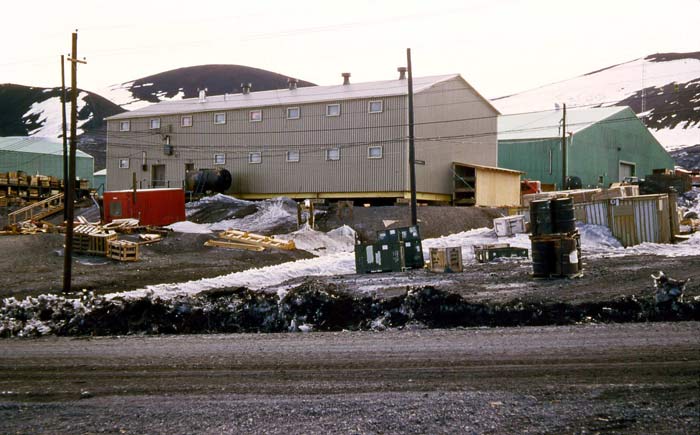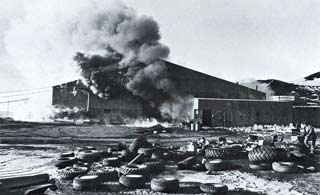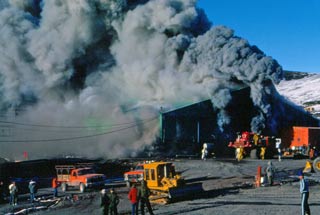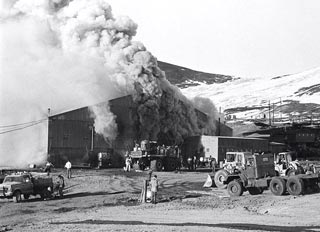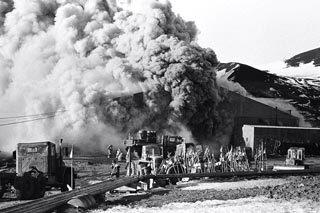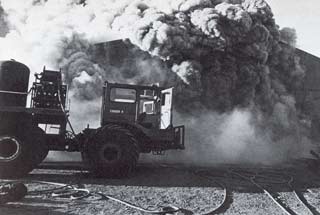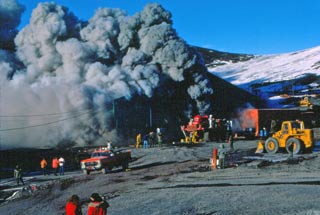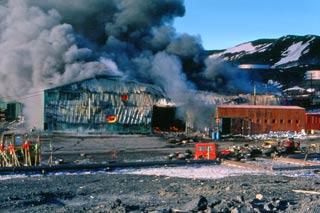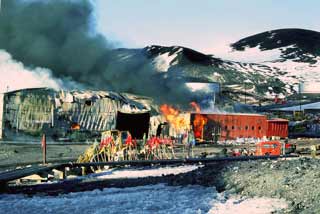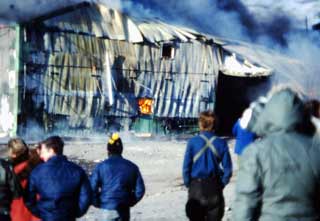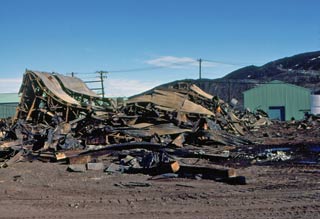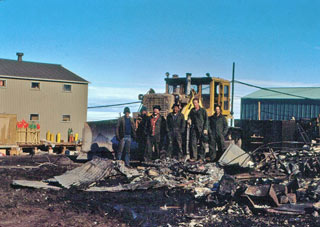McMurdo Garage Fire
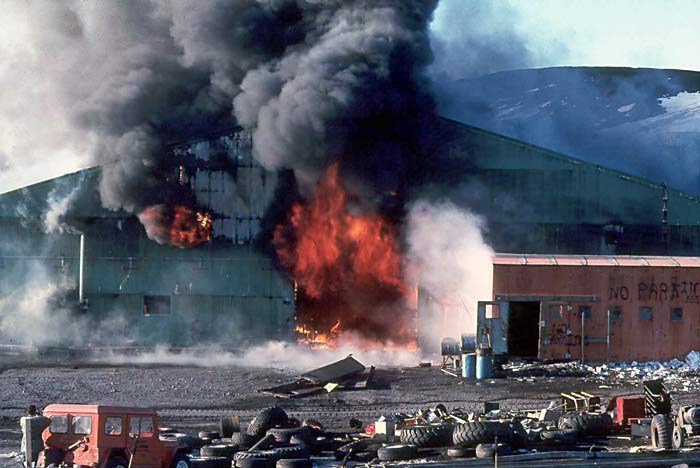
Above, the fire is raging; this is probably just after the bulldozer pushed through the door in a final
attempt to rescue the new fire engine which was inside (photo from Allen Cull).
|
[The brief article below appeared in the the December 1981 issue of the Antarctic Journal.]
Fire destroys garage at McMurdo StationOn the evening of 1 December 1981 a fire of unknown origin destroyed one of McMurdo Station's two garages. Although the night crew noticed smoke and flames coming from the garage's metal shop and evacuated the building, the garage and its contents could not be saved. The building housed vehicles and heavy equipment repair facilities along with a technical library, shops for sheet metal work, welding and fabrication, and other machine work, and a battery room. Five vehicles---two passenger vans, the Captain's jeep, a dump truck, and a new fire truck (!) were inside and were lost in the fire. Three firefighters sustained minor injuries; two were treated for smoke inhalation and one for a facial cut.
Temporary facilities were established immediately so that the station's transportation and repair needs could be adequately met. As a safety precaution, the remains of the destroyed building will be demolished before the end of the 1981-1982 austral summer. Above is the only good "before" photo that I could find of what was officially known as the Public Works Transportation Building, although it is mostly hidden behind the Public Works building. I took this in December 1972 (you can also see it in some of my Observation Hill panoramas). It was a unique structure for McMurdo, as it was not a prefabricated Robertson building like the other structures which had been built from the mid 1960's. Instead, was constructed from a steel frame which had originally been fabricated for an aircraft hangar, but which had been cut down to a smaller size, with changed door and sidewall arrangements. The exterior was constructed of galvanized sheet metal with fiberglass insulation. The structure actually was a building within a building; the main structure was 122 x 112 feet, and within it was a smaller 2-story structure housing offices, storage, and shop spaces. The area not occupied by the inner structure (about 8,000 square feet) was the vehicle and equipment maintenance shop. This part of the facility had a flooring system of heavy timbers resting on the subgrade. The site work, subfloor, and flooring system was constructed during the 1965-66 season by a detachment of MCB 6; the facility was completed in 1966-67 by a new Seabee unit, the Naval Construction Battalion Unit (NCBU) 201, which had been created to provide more continuity and specialization for Antarctic construction projects. By comparison, the newer Public Works facility in the foreground of the above photo is a more conventional pre-engineered Robertson building with concrete footings and an elevated steel foundation; it was completed in 1970-71. Until it was completed, some of the Public Works offices and some of the trade shops had also been housed in the garage building. When I visited these facilities in December 1972, the timber deck in the garage building was already in rather poor shape due to melting of the frozen subsoil, exacerbated by all of the petroleum products and water from melted snow which seeped down between the timbers. In fact, at the time of the fire, a project to relevel and replace the 10x12 timbers in the floor deck was underway. The first third of the timber floor had been replaced the previous season; just before the fire, the rest of the floor had been demo'd, the subsoil dug out, liquids pumped out of the hole, and the excavation backfilled with fresh fill. A few days before the fire, a friend was participating in a refresher firefighting course. The fire marshal told the group that the building had been condemned as a fire hazard, but as it was required, it was still being used. And at that time a group was holding a barbecue inside, although that didn't have anything to do with the cause of the fire. Things started to get interesting on that evening, Tuesday, 1 December...to set the stage, it seems that the movie on AFRTS was "Fire on Ice." | |
|
There was some sort of meeting in the Chalet that evening; all of the senior military and civilian people on station were there. And suddenly everyone's beeper went off at the same time... | |
|
By the way, I should add that there IS VIDEO. Two versions...first, this wmv (Windows Media Video) file...and also this MP4 file which may work better on Macs. This was shot by Allen Cull and has been on his web site, which unfortunately he's still reconstructing. (Sadly, this video has been used in recent years as a USAP training video, but without credit.) The amazing thing to watch for here is when the dozer pushes in through the garage door, perhaps in an attempt to retrieve the fire engine which was inside. That ventilated the fire and it took off. (Note, there is no audio.) | |
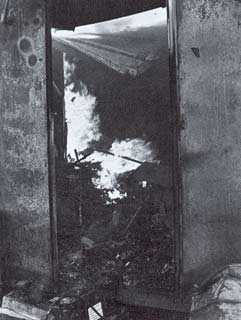 A closer look at the fire burning in one of the storage areas. |
|
|
After the fire was out and things had cooled off, there were a few things lying around that needed to be cleaned up... | |
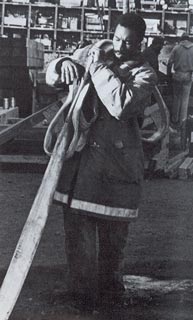 The Fire Department had a few cleanup tasks as well. Here's HT2 Gregory Higgs, the w/o fire marshal, putting hoses away. | |
|
The cause of the fire was determined to be the electric incinerating toilet, which had been installed only 3 days earlier. Reportedly someone put some paper into it (which was a no-no) and it caught fire...by the time they could return with a fire extinguisher, the wall behind it was fully engulfed. Remember, at this time the water and sewer infrastructure was rather limited, mostly due to the limited capabilities of the flash desalinization units on Ob Hill at the site of the former nuclear plant. And speaking of water...it was reported that the Fire Department almost had the fire under control when they ran out of water. In addition to the new fire truck (received during ship offload the previous summer), other vehicles destroyed included the Commanding Officer's jeep (CNSFA CAPT Jare M. Pearigen), a USARP van and a dump truck; all were in there for PM's. It would take at least five days to cut apart the remains and haul them up the hill to be buried...and it would take until about 1988 before a permanent replacement structure (the current "heavy shop," which is constructed of noncombustible materials on a raised foundation and with fire suppression) would be completed. In the meantime, shop space was created in the USARP garage and eventually in the old "Penguin Power & Light" power plant building, which is still in use today as facilities maintenance shop space. Unless noted otherwise, all of the color photos are from Nick Majerus, and the black-and-white photos are from the DF-82 NSFA cruisebook. |
|
